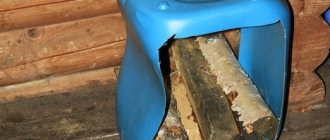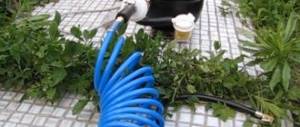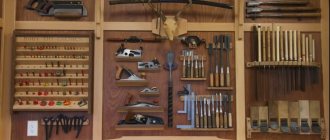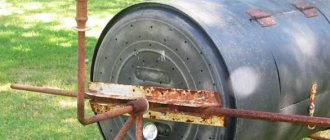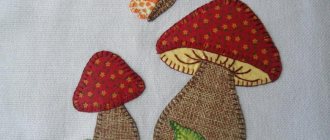The 5 in 1 transformable ottoman helps out in small spaces.
The 5 in 1 transformable ottoman belongs to multifunctional furniture and is a panacea for modern people who are accustomed to convenience and space at the same time. Furniture based on the matryoshka principle, as in the photo, will surprise no one; the apartments offered for living are becoming smaller and smaller, and the furniture market is replenished with cutting-edge inventions that make it possible to create a comfortable environment in the room without taking up much space.
The phrases 2 in 1, 3 in 1 have become familiar, but 5 in 1 makes you think. The video in this article demonstrates the advantages of a small transformable ottoman, which with a slight movement of the hand turns into a table, sofa, armchair, bed, couch, TV stand, minibar, etc.
Features of the pouf
The undoubted advantage of this type of upholstered furniture is its compactness. This is a very important quality that makes poufs a universal option for our non-
too spacious hallways. Its lightness and small size make it easy to carry it around the house or put it away when not needed.
A design feature of most models is the presence of empty space inside, which makes it possible to use them as additional storage space. An ottoman is also a wonderful decorative element.
Square pouf
The simplicity and laconicism of the form of this model is suitable for any hallway. Excessive severity of lines will be set off by bright textiles selected to your taste.
This option is very easy to make at home. As a result, the finished product has the following dimensions:
- width – 400 millimeters;
- height – 450.
To create this comfortable hallway seat, prepare:
- Chipboard (remnants of old furniture will come in handy) or plywood 12 millimeters thick;
- pine block 40 by 40 millimeters;
- foam rubber thinner than 4 cm;
- padding polyester or batting;
- suitable upholstery material (specifically for the hallway it is best to take leatherette);
- non-woven fabric for the base;
- decorative buttons 20 pcs.;
- PVA glue;
- wood screws 45 mm;
- stapler and staples for it;
- nylon threads;
- jigsaw;
- screwdriver;
- sewing machine;
- pencil or marker;
- scissors;
- centimeter.
Work order:
- we cut out 4 walls of 400 by 400 millimeters from chipboard, and also a seat - 432 by 432 mm;
- We fasten the sidewalls together with self-tapping screws using bars installed in the corners;
- fix the seat;
- glue foam rubber on top and let it dry;
- we make 4 holes (a square in the center of each face) for the ties;
- put padding polyester on the pouf;
- we stretch the cover, made according to the dimensions of the parts, taking into account the thickness of the filler;
- carefully thread the buttons through the holes on a strong thread and tighten the foam rubber (we nail the ends of the twine from the inside of the pouf with a stapler);
- We secure the lower edge of the upholstery with staples, slightly stretching the fabric;
- cover the bottom with a piece of non-woven fabric;
- We fix the legs to the ends of the bars (it is permissible to install rollers instead of them).
Components
At first glance, the differences between a simple ottoman and a transformer are not striking. It seems to be the same regular in the bedroom, living room, hallway, but 5-7 extra centimeters in size allows you to get amazing results.
So:
- A transformable ottoman can consist of 5 stools and then, when assembled, a soft pouf in the shape of a cube appears before your eyes. Ease of movement is provided by caster wheels. All seats and stool heights are made in the same dimensions. For production, a stainless steel mirror pipe and artificial leather of various colors and shades are used, allowing you to choose an ottoman for the specific interior of the room. The assembled dimensions of this design are 47x47x47 cm, the seat of the stool is 42x42 cm, the height is 41.5 cm.
- It is quite difficult to compare transformable ottomans with a full-fledged sleeping place for daily use, but for short-term accommodation of overstaying relatives they are quite sufficient. This product includes a fairly simple design of a transformable ottoman, also known as a tea table, couch, bed, sofa and other necessary pieces of furniture. It is made in the form of a hollow structure, reminiscent of a packaging box for fruit, that is, the bottom is made of slats, stuffed at intervals of 40-50 mm. Inside the box, 3 soft pillows connected to each other comfortably fit, and one of them is fixed to the other two with a zipper, and these two are folded out like a book. On top, the soft insides are covered with a lid, which, when removed, serves as a small table. The legs are recessed into the table lid and, if necessary, are simply removed into the light. All other elements can be freely transformed into the above items.
What a toy is for people of all ages
- A cheerful company of almost a dozen children can easily fit on one comfortable, soft ottoman, like the one in the picture above, reminiscent of a tangerine. Comfortable ottoman segments are connected with a zipper, and the insides are filled with soft filling. The top is decorated with a two-color removable fabric cover. It is easily removed and washed, and its main feature is that its “slices” can be combined in completely different ways. By connecting several slices with a zipper, you can relax comfortably on a sofa, armchair, bed, or just sit on horseback. Children are simply delighted with this invention, and when guests unexpectedly arrive, you can borrow this item from them and have a get-together, remembering your youth. An unusual combination of colors and a unique design can decorate any space, even in the office, country house, kindergarten or school. Although it can be assumed that such an item is unlikely to last long in good condition at school.
- A transformable ottoman bed is a newfangled invention, consisting of a wooden base, ceilings and soft upholstery. Upholstery includes various materials: upholstery fabric, leather (see Leather ottomans - not luxury, but individuality), leatherette, leatherette and many other products. The opportunities provided to order an ottoman bed allow you to obtain a product that meets the wishes of customers. The price of a pouffe bed will increase if it is equipped with a folding mechanism, the cost of which depends on the complexity of the design. Sales statistics show that the most popular designs have become those that allow you to sit near a table, which then quickly disappears, turning into an integral element of an ottoman.
Cylindrical pouf
This option is quite compact, but very strong and can withstand heavy loads. The absence of corners allows it to be used even in the smallest hallways.
You will need to prepare:
- 8 reinforcing furniture corners;
- a sheet of good plywood no thinner than 15 millimeters;
- four rollers capable of supporting 100 kg;
- a piece of old linoleum 96 by 35 centimeters;
- upholstery material for the cover (circle 42 cm in diameter and rectangle 120 by 50 cm);
- 13 mm self-tapping screws with a round head;
- 40 mm foam rubber and padding polyester;
- PVA;
- jigsaw
All wooden parts and their dimensions are shown in the drawing.
First, the cover is made. The material is folded together with padding polyester and cut according to the previously given dimensions. First of all, the side panel is sewn together, and then the round seat element is attached to it. A drawstring is made at the bottom and a lace or elastic is threaded through it.
Plywood spacers, as well as the base and lid, are fastened together with furniture corners and self-tapping screws. Linoleum is placed in a circle - it will create rigid walls. It is fixed with screws along the vertical and horizontal edges of the frame.
Foam rubber is glued on top of the base using PVA. After the fixing composition has dried, rollers are installed on the bottom of the pouf. All that remains is to put a sewn cover on it ahead of time.
From car tires
This option is quite interesting, since it makes it possible to get rid of old tires in one fell swoop and provide your apartment with new, comfortable furniture. The standard set of rubber includes 2 beautiful, reliable ottomans.
You will need for 1 piece:
- 6 bolts with nuts and washers;
- a piece of plywood or chipboard for the seat;
- self-tapping screws;
- foam;
- padding polyester
Old tires should be thoroughly washed from dirt and completely dried. After this, they are laid in pairs on top of each other and 6 holes are drilled in the inner sides, through which bolts and washers are passed. By tightening the nuts tightly, you will get a strong, permanent connection.
Next, a strip 60 centimeters wide and a length equal to the radius of your wheels is cut out of suitable fabric and padding polyester. Both materials are machine stitched around the perimeter (making a drawstring on one side) and the narrow edges are sewn together. Thread the elastic through and pull the upholstery onto the frame.
The chipboard seat is covered with foam rubber and covered with textiles using a stapler. It is attached to the tires with self-tapping screws from the inside out.
The last stage is installing the bottom. It is made from plywood. If desired, you can attach plastic legs.
Experts tell us how to reupholster an ottoman with your own hands
Purchasing new furniture is always an exciting journey through specialized stores, a feeling of euphoria from making a purchase and a pleasant aftertaste from installation. But what to do if you simply don’t have enough money to buy something new? An excellent alternative to purchasing a new piece of furniture is restoring the old one. In this way, you can preserve what is left of your beloved grandmother, and at the same time show your creative thinking.
Let's try to tell you in detail how to restore an old pouf. After all, such a piece of furniture will look harmonious both in the living room and hallway, and in the bedroom in front of the dressing table. We will look at a solid wood ottoman with wooden legs and sagging upholstery, the upholstery fabric will also be replaced.
Necessary materials
Before you begin, you should collect everything you will need during the restoration. After all, once the process has already begun, it will be difficult to get distracted in search of this or that tool. So, the required items to use:
- fabric for upholstery (you can choose any fabric, the main thing is that you like it and match the color and style of the room where the new ottoman will “live”;
- stapler for furniture;
- sandpaper with coarse and fine grains, and a handle holder for it;
- foam rubber;
- wood varnish or stain, as well as brushes for them;
- scissors;
- threads and needles;
- pliers and screwdriver.
You should choose in advance a place where to lay out all the accessories and you can get to work.
To the barrier!
As a rule, work begins with the inspection and restoration of wooden legs. They need to be sanded - to remove all roughness and create a smooth surface. To do this, you need to install coarse-grained sandpaper on the handle and go through it, smoothly moving to fine-grained sandpaper when polishing is needed.
Before varnishing, it will be necessary to coat the wood with stain so that the varnish does not subsequently chip and lays flat. The varnish is applied when the stain has already dried.
Now you can move on to the reupholstery. To do this you need to prepare the fabric. It is advisable to choose it in advance and think about the footage. Of course, you should take it with a reserve. Of the entire range, it is better to give preference to durable fabrics with a percentage of synthetic fibers of at least 60.
The old upholstery is removed using a screwdriver and pliers. You should remove it carefully in order to make the correct pattern later. The new fabric is laid out wrong side up, the old material is applied on top, and the outline is outlined with thin soap, chalk or a construction pencil. Next, the pattern is cut out and put on the pouf.
Replacing foam rubber is done by applying new material to the cut fabric.
The foam rubber is attached to the pouf along with the fabric and fastening with a furniture stapler begins. First, one side is attached, and then the fabric is stretched, and gradually the transition occurs to the other sides. Under no circumstances should the fabric sag, otherwise the appearance of the product will be lost at the very beginning. If you see any unevenness at this stage, just carefully remove the bracket with pliers and re-fasten it with a new one.
Buttons are often chosen as decorative elements; they are also covered with fabric that is used to cover the pouf. The buttons are sewn on with a needle and thread; they should be positioned so as not to interfere with comfortable sitting. Decorative elements are sewn on only when the plating is finished. And everything is ready!
Source - https://skay-nine.ru



